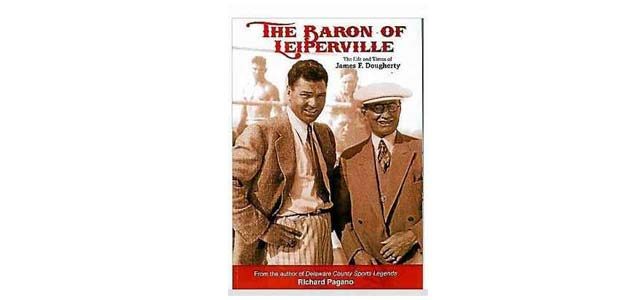The Baron of Leiperville – The Life and Times of James F. Dougherty!
Writer Damon Runyon dubbed Baron Dougherty “The Baron of Leiperville”. There was an establishment called Billie Richie’s Hotel & Bar at 1436 Chester Pike in Crum Lynne, PA, between Chester and Philadelphia.
In the rear of the Colonial Hotel was first a gymnasium, then a ring under a tent and eventually a boxing arena which held 5,000 fans. It was there that some of the greatest fighters in the sport either trained or fought there. Names like Jack Johnson, Joe Gans, Jack Blackburn, Two-Ton Tony Galento, Johnny Kilbane, John Henry Lewis, Tony Canzoneri, Maxie Rosenbloom, “Sugar” Ray Robinson, Billy Conn, Benny Bass, Mickey Walker, Kid Chocolate, Vince Dundee, Fritzie Zivic, Joey Maxim, George Godfrey and Jack Dempsey.
It was established that Runyon wrote, “Little Miss Marker” on one of his long stays at the hotel. That was the tearjerker that later became a memorable 1934 movie starring Shirley Temple and Adolph Menjou.
Dougherty became the manager of Jack Johnson for the early bouts of his career. He befriended world lightweight champion Joe Gans and had him examined by his doctor, where it was discovered that the legendary fighter had tuberculosis. Dougherty then loaned Gans money so he could get to the west coast, where he engaged in that memorable 42-round championship fight with Battling Nelson.
Dougherty thought he finally had his heavyweight champion when he was managing George Godfrey during the 1920’s. Unfortunately, Godfrey would never get a shot at Dempsey’s world title because the champion drew the color line and would not fight a black boxer.
This writer was told by Joe Shannon who was trained by Jack Blackburn and knew Dougherty well that Dempsey and Godfrey sparred and Godfrey bragged later to some people how he got over on Dempsey. When word got back to Dempsey the next time they sparred Dempsey beat the hell out of Godfrey.
Dempsey was accused of ducking Harry Wills but said the only boxer he ducked was Sam Langford, the “Boston Tar Baby”. It’s a fact that even the first black heavyweight champion Jack Johnson drew the color line. He was eventually forced to fight a black and it was No. 7 ranked in the color rankings Jim Johnson. They fought in Paris, France to a 20-round draw.
Dougherty obtained probably his greatest national attention when he was the third man in the ring for the Jack Dempsey-Tommy Gibbons heavyweight championship bout in Shelby, MT. Having already refereed two of Dempsey’s previous fights he was handpicked by the champion’s manager Doc Kearns to work this fight.
Dougherty took in Dempsey who was hungry and down and out and provided him a job waiting on tables at his hotel, while he was training for his 1918 fight with Battling Levinsky. A year later, Dempsey took the world title from Jess Williard in Toledo, OH.
Dougherty was instrumental in getting Jack Blackburn released from Eastern Penitentiary, where he then built Joe Louis into a world champion and the most feared heavyweight puncher in modern history. In the rear of the Colonial Hotel was first a gymnasium, then a ring under a tent and eventually a boxing arena which held 5,000 fans.
In what was known as the “great scam” Kearns was offered $100,000 to have Dempsey fight Tommy Gibbons. Seems Johnson offered Kearns 50,000 sheep instead of the money. Kearns said “what the hell am I going to do with 50,000 sheep in New York?” Johnson leased most of his cattle and his oil properties, borrowed the rest, and somehow came up with the final $100,000. Kearns was determined to get the entire $300,000 that the original contract called for, and he got it. Dougherty’s fee as the referee was $5,000 the most any third man in the ring had ever received up until that time.
People in attendance work shocked that Gibbons went the distance. When referee Dougherty the sole judge raised the hand of Dempsey it was a mere formality.
At a very young age, Dougherty was very athletically inclined. Baseball was his first love and then he got interested in boxing. When he was 17, his family moved out of Chester, and went east on Chester Pike to Leiperville, today known as Crum Lynne.
With the closing of the Boxing Club in Essington, Dougherty was back in business again promoting. However, he was also busy managing Eddie Lenny, who would get the opportunity to fight for the world featherweight championship under Dougherty’s management.
Shannon told this writer heavyweight champion Jack Dempsey was in Dougherty’s Gym in the office upstairs. He looked through a window down into the gym and noticed a young boy without the proper apparel and told Dougherty to take him to the nearest sporting good store and clothe the kid in whatever necessary. He added not to tell the owner he was paying for this. Word eventually got out against the wishes of Dempsey.
In 1905, land at times using Dougherty as his manager, (Jack) Johnson fought 10 out of his next 12 fights in Philadelphia. That same year, Jeffries retired his world heavyweight championship, and Marvin Hart and Tommy Burns fought for the vacant title in 1906. Burns was victorious, and for the next two years Johnson stalked Burns and taunted him in the press to give him a shot at the title. Finally in 1908, Johnson got his opportunity and defeated Burns for the world heavyweight championship in Sydney, Australia.
“Jack Dempsey was the one who I let get away,” said Dougherty. In the spring of 1916, the 20 year old Dempsey and his manager Jack Price arrived in New York for his first fight there. For his second fight in the Big Apple, Dempsey again won and the sportswriters such as Damon Runyon started to pay attention. This fight took place at the Harlem Sporting Club. At the age of 24 Dempsey became the new world champion.
Most of what has been written in this article were from the book Richard Pagano wrote. He is the author of Delaware County sports Legends. He is a sport historian who has been writing a weekly column for the News of Delaware County and Town Talk Newspapers since 1987. He is a member of the Philadelphia Sports Writers Association, the oldest organization of its kind in the nation. In 1991, he was inducted into the Pennsylvania Sports Hall of Fame for his Sports Journalism. I highly recommend this 213 page paperback book.
https://books.google.com/books/about/The_Baron_of_Leiperville.html?id=18PQoAEACAAJ


